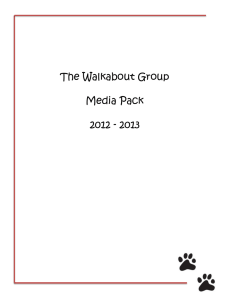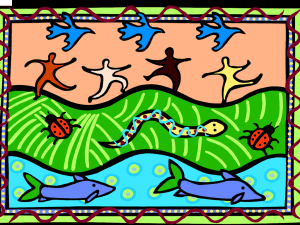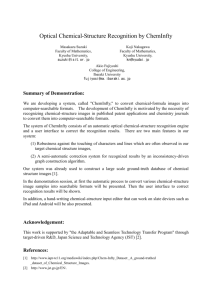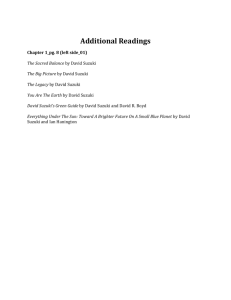Let`s go on a … WALKABOUT Nature Connections and Collections
advertisement
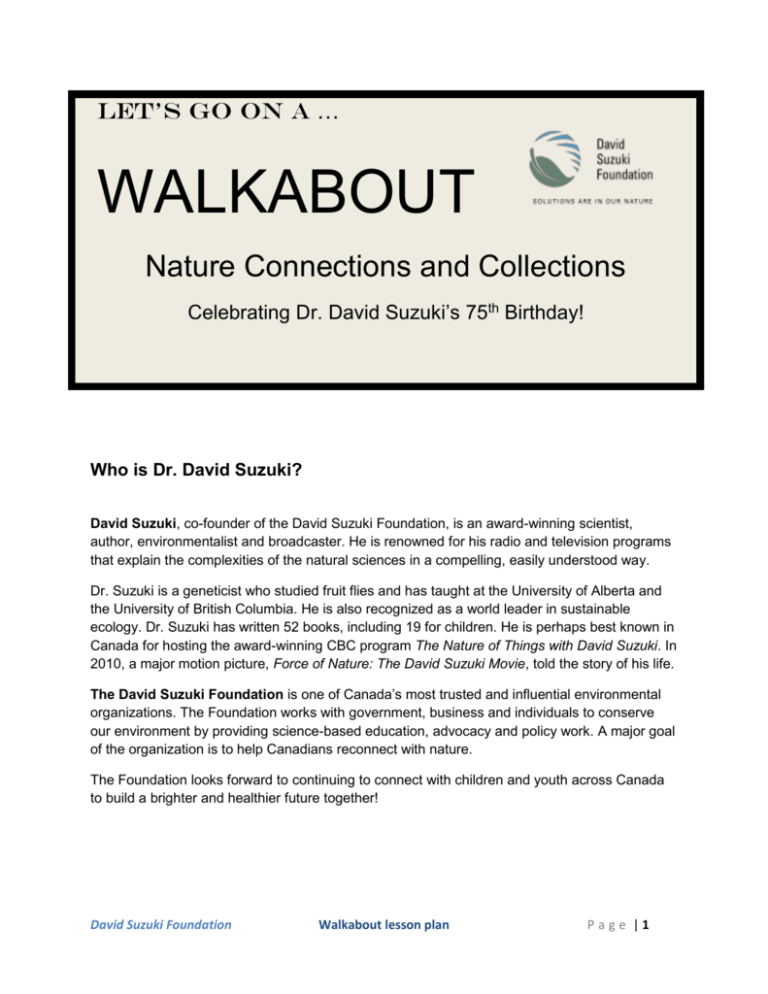
Let’s go on a … WALKABOUT Nature Connections and Collections Celebrating Dr. David Suzuki’s 75th Birthday! Who is Dr. David Suzuki? David Suzuki, co-founder of the David Suzuki Foundation, is an award-winning scientist, author, environmentalist and broadcaster. He is renowned for his radio and television programs that explain the complexities of the natural sciences in a compelling, easily understood way. Dr. Suzuki is a geneticist who studied fruit flies and has taught at the University of Alberta and the University of British Columbia. He is also recognized as a world leader in sustainable ecology. Dr. Suzuki has written 52 books, including 19 for children. He is perhaps best known in Canada for hosting the award-winning CBC program The Nature of Things with David Suzuki. In 2010, a major motion picture, Force of Nature: The David Suzuki Movie, told the story of his life. The David Suzuki Foundation is one of Canada’s most trusted and influential environmental organizations. The Foundation works with government, business and individuals to conserve our environment by providing science-based education, advocacy and policy work. A major goal of the organization is to help Canadians reconnect with nature. The Foundation looks forward to continuing to connect with children and youth across Canada to build a brighter and healthier future together! David Suzuki Foundation Walkabout lesson plan Page |1 What’s the point? In this interactive activity, students in all grades will experience nature first-hand by spending time in the schoolyard or nearby park and sharing their observations, collections and ideas about nature with each other. Discussions will lead to an understanding that everything is connected to nature and that nature is all around us (country and city) and must be protected and nurtured. What you do Outdoor Activity (Part 1) (To be completed before part 2 but not necessarily on consecutive days. The activity can be completed rain or shine!) Supply each student with a writing tool and paper (optional: mobile device camera phones). Do a walkabout around the schoolyard or nearby park to observe the nature around you. What do you see, hear, smell and touch? Focus on one particular observation and record it on paper or on a camera phone. Allow students to express themselves by choice (pictures, photos or words) while observing the nature in the schoolyard or park. Observations should focus on “What is nature?” Circulate and share pictures and/or photos with each other. Make observations about differences and similarities. Debrief using the questions from: What’s the connection? Activity extension: Students collect “nature items” they find during their walkabout and bring them to a large area (outdoors or indoors) where they can create a “collage” of their experiences. Indoor Activity (Part 2) (To be completed after part 1) Use the same paper as for the outdoor activity (use opposite side). Ask students to use only one word that answers the following question: “What is nature?” Answers may be derived from the walkabout observations or from the nature collections. Print the word large enough to fill the page. Students using mobile phones can either use paper for this activity or may type the word on their device. Instruct the students to stand with their paper and hold it in front of them so others can read it. Have everyone circulate around the room, silently looking at all ideas of the other students (for a minute or two). Younger students can circulate sharing their word orally while showing their walkabout picture. Signal for students to stop and find the nearest person to form pairs. In pairs, spend one minute explaining their word and their reasons for choosing it. Have everyone circulate around again and ask students with similar words to stand together in groupings. Observe the different nature groupings. Debrief using the questions from: What’s the connection? Activity extension: Student pictures and/or camera photos can be collected to create a bulletin board or an electronic slideshow. David Suzuki Foundation Walkabout lesson plan Page |2 What you need paper; one 8 1/2” x 11” sheet per student mobile device camera phones (optional) wide-tip felt markers; one for each student dictionary definition of nature nature items collected from the walkabout (optional) Time required Outdoor Activity: 20 min walkabout + observations/collages Indoor Activity: 10 minute activity + discussionsuzuki.org/Nat Teacher Tip Have students use a hardcover book to support their paper for the outdoor walkabout activity. Remind students the day before to dress appropriately for the outdoor activity (weatherappropriate clothing). What’s the Connection? Outside Activity What did you see, feel, smell and touch? Do you feel differently when you are outside instead of inside? How? How much nature did you see on your walk? What was missing? What would make your schoolyard more natural? Why is nature important? What is our connection to nature? Nature collage: What do you notice about the collage of collections? Can they be sorted into groupings? Do the items connect to each other? How? Indoor Activity What are the different nature groupings? How are they different from each other? How similar? How are the groups connected to each other? Are any ideas more right than others? Explain. How do the ideas of the class compare to a dictionary definition of nature? How is nature connected to people? How do we affect nature and vice versa? David Suzuki Foundation Walkabout lesson plan Page |3 Questions for Dr. David Suzuki Each class can ask two questions for David Suzuki based on observations made during the walkabout activity or classroom discussion. Your school’s submissions may be selected and answered by Dr. David Suzuki during the webinar. Email Address: questions@davidsuzuki.org (submission deadline is March 16, 2011). Please fashion the questions around the concept of “how people are connected to nature” or “how we affect nature and vice versa”. Include the following information: Student name: Grade: School: City and province: Teacher name: Teacher contact email and phone number: Questions for Dr. Suzuki: Why does it matter? Whatever we do to nature we do to ourselves. Once we realize that everything is connected, we can see that what we do every day in our lives affects not only animals and plants but, ultimately, ourselves. Taking it further Play a game to reinforce the point that nature is all around us. Pick up an object in the classroom and say, “I am connected to nature. What’s my connection?” To help students find the connection, ask them to consider what it is made of and how it was made. For example, pick a book and ask how it is connected to nature. Answers you might get are: 1) It is made from trees. 2) It uses ink made from vegetables and other dyes. 3) It can teach us about nature. 4) It will eventually disintegrate back into nature. Now, let students select an object for a presentation on the connections they see. Discuss the range of connections that could be made. Add another level of challenge to the game by having students find the connections to nature of two objects and the connections between them. Ask your students to create a diagram that explores what this quote below is telling us. Where in the diagram is there a possibility of a problem? Discuss the point. “One hundred trout are needed to support one man for a year. The trout, in turn, must consume 27 million grasshoppers that live off 1,000 tonnes of grass.” G. Tyler Miller, jr., Author and environmentalist Read the book The Lorax by Dr. Seuss. How did the author make the ideas easy to understand? Alternative: There’s a Barnyard in My Bedroom by David Suzuki. Greening your schoolyard Make your schoolyard a more natural space to “connect with nature”. Create a vegetable garden, make some birdhouses or add more trees, mulch, rocks, bushes, etc. Get started today by going to http://www.evergreen.ca/en/programs/schools/. David Suzuki Foundation Walkabout lesson plan Page |4
